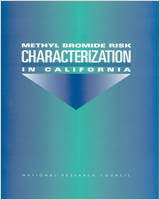NCBI Bookshelf. A service of the National Library of Medicine, National Institutes of Health.
National Research Council (US) Subcommittee for the Review of the Risk Assessment of Methyl Bromide. Methyl Bromide Risk Characterization in California. Washington (DC): National Academies Press (US); 2000.
Air exchange rates are defined in terms of a general one-compartment model of air exchange with immediate and perfect mixing of air inside residences. For any contaminant in the assumed well-mixed pool of air in the living spaces, this leads to an expectation of simple exponential decline of air concentrations with time:
C(t)=C(0)e−kt,
where C(0) is the initial concentration of the contaminant inside the house, C(t) is the concentration of the contaminant at any specific time after t=0, and k is a rate constant in units of reciprocal time (i.e., if time is expressed in hours, k is in reciprocal hours, or, by convention, “air changes per hour”). The relationship between the rate constant k and the half-life (the time required to reduce the air concentration by half) is easily derived by setting C(t) to one-half of C(0):
C(t1/2)=.5C(0)=C(0)e−kt1/2,
After the cancellation of the C(0)'s, and taking the natural logarithm of both sides of the equation:
ln(.5)=−kt1/2
t1/2=ln(2)/k or k=ln(2)/t1/2
ILLUSTRATIVE LOGNORMAL TREATMENT OF DATA FOR SELECTED OCCUPATIONAL EXPOSURES
Figure A–1 shows lognormal probability plots of the individual data points for several groups of workers in the shallow-shank tarp method application of methyl bromide. In this type of plot, correspondence of the points to the regression line is a quick qualitative indicator of the degree to which the data points are well described by the chosen distribution. In these cases, the fits are far from perfect, suggesting some possible heterogeneity in the data, but the lognormal plots in Figure A–1 are generally better than corresponding normal distribution fits (Figure A–2). For these same worker groups, Table A–1 below compares the reported highest observed values with 95th percentile values calculated from the fitted normal and lognormal distributions. In general, the lognormal fits project somewhat higher 95th percentiles than the normal fits.
TABLE A–1
Comparison of Observed Values with 95th Percentile Values.
- Calculation of Air Exchange Rates - Methyl Bromide Risk Characterization in Cali...Calculation of Air Exchange Rates - Methyl Bromide Risk Characterization in California
Your browsing activity is empty.
Activity recording is turned off.
See more...


